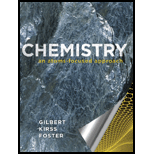
Chemistry: An Atoms-Focused Approach
14th Edition
ISBN: 9780393912340
Author: Thomas R. Gilbert, Rein V. Kirss, Natalie Foster
Publisher: W. W. Norton & Company
expand_more
expand_more
format_list_bulleted
Question
Chapter 7, Problem 7.9QA
Interpretation Introduction
To find:
Which, among the reactants and products from Question 7.8, has the largest molar mass
Expert Solution & Answer
Want to see the full answer?
Check out a sample textbook solution
Students have asked these similar questions
If we assume a system with an anodic overpotential, the variation of n as a function
of current density:
1. at low fields is linear 2. at higher fields, it follows Tafel's law
Obtain the range of current densities for which the overpotential has the same value
when calculated for 1 and 2 cases (maximum relative difference of 5% compared to
the behavior for higher fields).
To which overpotential range does this correspond?
Data: i = 1.5 mA cm², T = 300°C, B = 0.64, R = 8.314 J K1 mol-1 and F = 96485 C mol-1.
Answer by equation please
Some of the theories used to describe interface structure can be distinguished by:1. the measured potential difference.2. the distribution of ions in solution.3. the calculation of charge density.4. the external Helmoltz plane.
Chapter 7 Solutions
Chemistry: An Atoms-Focused Approach
Ch. 7 - Prob. 7.1VPCh. 7 - Prob. 7.2VPCh. 7 - Prob. 7.3VPCh. 7 - Prob. 7.4VPCh. 7 - Prob. 7.5VPCh. 7 - Prob. 7.6VPCh. 7 - Prob. 7.7QACh. 7 - Prob. 7.8QACh. 7 - Prob. 7.9QACh. 7 - Prob. 7.10QA
Ch. 7 - Prob. 7.11QACh. 7 - Prob. 7.12QACh. 7 - Prob. 7.13QACh. 7 - Prob. 7.14QACh. 7 - Prob. 7.15QACh. 7 - Prob. 7.16QACh. 7 - Prob. 7.17QACh. 7 - Prob. 7.18QACh. 7 - Prob. 7.19QACh. 7 - Prob. 7.20QACh. 7 - Prob. 7.21QACh. 7 - Prob. 7.22QACh. 7 - Prob. 7.23QACh. 7 - Prob. 7.24QACh. 7 - Prob. 7.25QACh. 7 - Prob. 7.26QACh. 7 - Prob. 7.27QACh. 7 - Prob. 7.28QACh. 7 - Prob. 7.29QACh. 7 - Prob. 7.30QACh. 7 - Prob. 7.31QACh. 7 - Prob. 7.32QACh. 7 - Prob. 7.33QACh. 7 - Prob. 7.35QACh. 7 - Prob. 7.36QACh. 7 - Prob. 7.37QACh. 7 - Prob. 7.38QACh. 7 - Prob. 7.39QACh. 7 - Prob. 7.40QACh. 7 - Prob. 7.41QACh. 7 - Prob. 7.42QACh. 7 - Prob. 7.43QACh. 7 - Prob. 7.44QACh. 7 - Prob. 7.45QACh. 7 - Prob. 7.46QACh. 7 - Prob. 7.47QACh. 7 - Prob. 7.48QACh. 7 - Prob. 7.49QACh. 7 - Prob. 7.50QACh. 7 - Prob. 7.51QACh. 7 - Prob. 7.52QACh. 7 - Prob. 7.53QACh. 7 - Prob. 7.54QACh. 7 - Prob. 7.55QACh. 7 - Prob. 7.56QACh. 7 - Prob. 7.57QACh. 7 - Prob. 7.58QACh. 7 - Prob. 7.59QACh. 7 - Prob. 7.60QACh. 7 - Prob. 7.61QACh. 7 - Prob. 7.62QACh. 7 - Prob. 7.63QACh. 7 - Prob. 7.64QACh. 7 - Prob. 7.65QACh. 7 - Prob. 7.66QACh. 7 - Prob. 7.67QACh. 7 - Prob. 7.68QACh. 7 - Prob. 7.69QACh. 7 - Prob. 7.70QACh. 7 - Prob. 7.71QACh. 7 - Prob. 7.72QACh. 7 - Prob. 7.73QACh. 7 - Prob. 7.74QACh. 7 - Prob. 7.75QACh. 7 - Prob. 7.76QACh. 7 - Prob. 7.77QACh. 7 - Prob. 7.78QACh. 7 - Prob. 7.79QACh. 7 - Prob. 7.80QACh. 7 - Prob. 7.81QACh. 7 - Prob. 7.82QACh. 7 - Prob. 7.83QACh. 7 - Prob. 7.84QACh. 7 - Prob. 7.85QACh. 7 - Prob. 7.86QACh. 7 - Prob. 7.87QACh. 7 - Prob. 7.88QACh. 7 - Prob. 7.89QACh. 7 - Prob. 7.90QACh. 7 - Prob. 7.91QACh. 7 - Prob. 7.92QACh. 7 - Prob. 7.93QACh. 7 - Prob. 7.94QACh. 7 - Prob. 7.95QACh. 7 - Prob. 7.96QACh. 7 - Prob. 7.97QACh. 7 - Prob. 7.98QACh. 7 - Prob. 7.99QACh. 7 - Prob. 7.100QACh. 7 - Prob. 7.101QACh. 7 - Prob. 7.102QACh. 7 - Prob. 7.103QACh. 7 - Prob. 7.104QACh. 7 - Prob. 7.105QACh. 7 - Prob. 7.106QACh. 7 - Prob. 7.107QACh. 7 - Prob. 7.108QACh. 7 - Prob. 7.109QACh. 7 - Prob. 7.110QA
Knowledge Booster
Similar questions
- When talking about the acidity of carboxylic acids, is it the same thing to say higher or stronger acidity?arrow_forwardUsing the following two half-reactions, determine the pH range in which $NO_2^-\ (aq)$ cannot be found as the predominant chemical species in water.* $NO_3^-(aq)+10H^+(aq)+8e^-\rightarrow NH_4^+(aq)+3H_2O(l),\ pE^{\circ}=14.88$* $NO_2^-(aq)+8H^+(aq)+6e^-\rightarrow NH_4^+(aq)+2H_2O(l),\ pE^{\circ}=15.08$arrow_forwardIndicate characteristics of oxodec acid.arrow_forward
- What is the final product when hexanedioic acid reacts with 1º PCl5 and 2º NH3.arrow_forwardWhat is the final product when D-galactose reacts with hydroxylamine?arrow_forwardIndicate the formula of the product obtained by reacting methyl 5-chloro-5-oxopentanoate with 1 mole of 4-penten-1-ylmagnesium bromide.arrow_forward
arrow_back_ios
SEE MORE QUESTIONS
arrow_forward_ios
Recommended textbooks for you
 ChemistryChemistryISBN:9781305957404Author:Steven S. Zumdahl, Susan A. Zumdahl, Donald J. DeCostePublisher:Cengage Learning
ChemistryChemistryISBN:9781305957404Author:Steven S. Zumdahl, Susan A. Zumdahl, Donald J. DeCostePublisher:Cengage Learning ChemistryChemistryISBN:9781259911156Author:Raymond Chang Dr., Jason Overby ProfessorPublisher:McGraw-Hill Education
ChemistryChemistryISBN:9781259911156Author:Raymond Chang Dr., Jason Overby ProfessorPublisher:McGraw-Hill Education Principles of Instrumental AnalysisChemistryISBN:9781305577213Author:Douglas A. Skoog, F. James Holler, Stanley R. CrouchPublisher:Cengage Learning
Principles of Instrumental AnalysisChemistryISBN:9781305577213Author:Douglas A. Skoog, F. James Holler, Stanley R. CrouchPublisher:Cengage Learning Organic ChemistryChemistryISBN:9780078021558Author:Janice Gorzynski Smith Dr.Publisher:McGraw-Hill Education
Organic ChemistryChemistryISBN:9780078021558Author:Janice Gorzynski Smith Dr.Publisher:McGraw-Hill Education Chemistry: Principles and ReactionsChemistryISBN:9781305079373Author:William L. Masterton, Cecile N. HurleyPublisher:Cengage Learning
Chemistry: Principles and ReactionsChemistryISBN:9781305079373Author:William L. Masterton, Cecile N. HurleyPublisher:Cengage Learning Elementary Principles of Chemical Processes, Bind...ChemistryISBN:9781118431221Author:Richard M. Felder, Ronald W. Rousseau, Lisa G. BullardPublisher:WILEY
Elementary Principles of Chemical Processes, Bind...ChemistryISBN:9781118431221Author:Richard M. Felder, Ronald W. Rousseau, Lisa G. BullardPublisher:WILEY

Chemistry
Chemistry
ISBN:9781305957404
Author:Steven S. Zumdahl, Susan A. Zumdahl, Donald J. DeCoste
Publisher:Cengage Learning

Chemistry
Chemistry
ISBN:9781259911156
Author:Raymond Chang Dr., Jason Overby Professor
Publisher:McGraw-Hill Education

Principles of Instrumental Analysis
Chemistry
ISBN:9781305577213
Author:Douglas A. Skoog, F. James Holler, Stanley R. Crouch
Publisher:Cengage Learning

Organic Chemistry
Chemistry
ISBN:9780078021558
Author:Janice Gorzynski Smith Dr.
Publisher:McGraw-Hill Education

Chemistry: Principles and Reactions
Chemistry
ISBN:9781305079373
Author:William L. Masterton, Cecile N. Hurley
Publisher:Cengage Learning

Elementary Principles of Chemical Processes, Bind...
Chemistry
ISBN:9781118431221
Author:Richard M. Felder, Ronald W. Rousseau, Lisa G. Bullard
Publisher:WILEY